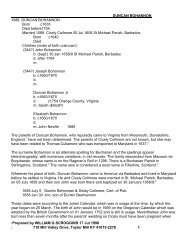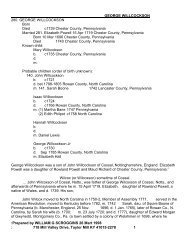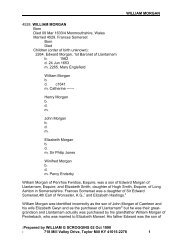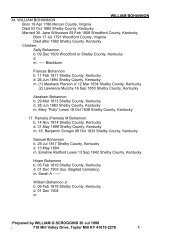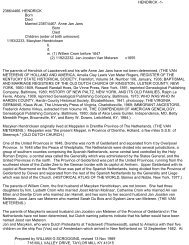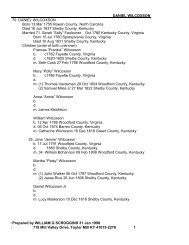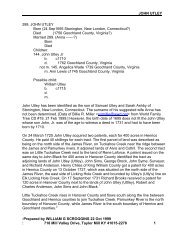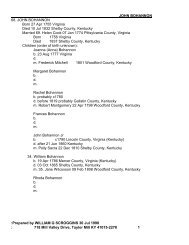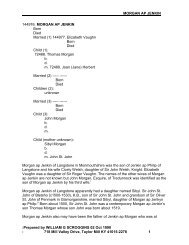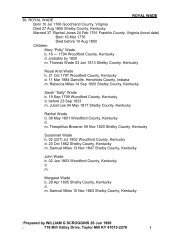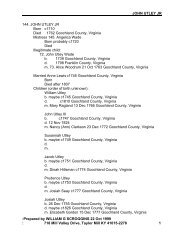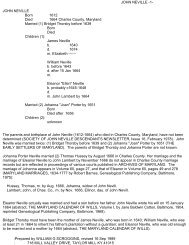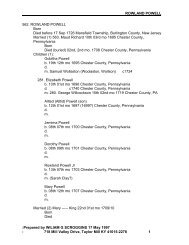SOMERSET - Genealogy Research Papers
SOMERSET - Genealogy Research Papers
SOMERSET - Genealogy Research Papers
You also want an ePaper? Increase the reach of your titles
YUMPU automatically turns print PDFs into web optimized ePapers that Google loves.
<strong>SOMERSET</strong><br />
9058. EDWARD <strong>SOMERSET</strong><br />
Born c1550<br />
Died 03 Mar 1627/8 London, England<br />
Married 9059. Elizabeth Hastings Dec 1571<br />
Born<br />
Died 24 Aug 1621 London, England<br />
Children (order of birth unknown):<br />
William Somerset, Lord Herbert<br />
b. c1576 Herefordshire, England<br />
d. Jan 1597/8<br />
m. not<br />
Henry Somerset, Earl of Worcester, Lord Herbert<br />
b. c1577 Herefordshire, England<br />
d. Dec 1646<br />
m. Anne Russell 1660<br />
Sir Thomas Somerset, Viscount Somerset<br />
b.<br />
d. 1651<br />
m. Eleanor Buttevant<br />
Sir Charles Somerset<br />
b.<br />
d.<br />
m.<br />
(4 other sons)<br />
4529. Frances Somerset<br />
b.<br />
d.<br />
m. 4528. William Morgan<br />
Lucy Somerset<br />
b.<br />
d.<br />
m. Henry Herbert<br />
Elizabeth Somerset<br />
b.<br />
d.<br />
m. Sir Henry Guldeford of Hemsted<br />
Edward Somerset, 4th Earl of Worcester and Knight of the Garter, was the only son and<br />
heir of William Somerset, 3rd Earl of Worcester, and his first wife Christian North.<br />
:Prepared by WILLIAM G SCROGGINS, 02 Mar 1997<br />
: 718 Mill Valley Drive, Taylor Mill KY 41015-2278 1
<strong>SOMERSET</strong><br />
Elizabeth Hastings was the fourth daughter of Francis Hastings, 2nd Earl of Huntingdon,<br />
and Catherine Pole, daughter of Sir Henry Pole, Baron Montagu (Montacute), and Jane<br />
Neville.<br />
William Morgan, Esquire, of Penrhos Fwrdios, who married Frances Somerset, was a<br />
son of Edward Morgan, Esquire, of Llantarnam, and Elizabeth Smith, daughter of Hugh<br />
Smith, Esquire, of Long Ashton in Somersetshire. William died on 09 March 1633/4 in<br />
Monmouthshire, Wales.<br />
Anne Russell, who married Henry Somerset, was a daughter of Francis Russell, 2nd<br />
Duke of Bedford. In 1597, her mother Lady Elizabeth Russell attempted to arrange a<br />
marriage between her eldest daughter Bess and William Somerset. Henry and Anne<br />
Russell Somerset had a son Sir John Somerset who married Mary Arundell, daughter of<br />
Thomas Arundell, Lord of Wardour Castle. They had a son Sir Charles Somerset who<br />
married Catherine Baskerville Sawyer, daughter of Walter Baskerville and widow of<br />
George Sawyer, Esquire. They had a daughter Lady Mary Joanna Somerset who<br />
married (1) Colonel ---- Lowther in England, who died enroute to Maryland. She married<br />
(2) Richard Smith, Jr. of Calvert County, Maryland:<br />
Capt. Richard [Smith, Jr.], of St. Leonard’s [Creek, Calvert Co.], d. 1714; m. (1)<br />
Elizabeth Brooke, of Brooke Place Manor, dau. of Robert and Mary Mainwaring<br />
Brooke; m. (2) Barbara Morgan, widow of John Rousby, of Cal[vert] Co., July 13,<br />
1686; m. (3) Maria Joanna, widow of Col. Lowther and dau. of Chas. Somerset,<br />
Esq., of Middlesex, Hertfordshire, England. Issue by all three wives. [Ref.]<br />
(Christopher Johnson, genealogical authority; Maryland Historical Magazine)<br />
Mary Joanna Somerset and Richard Smith were the parents of Charles Somerset Smith<br />
who married Jane Crabb, daughter of Thomas Crabb of Charles County, Maryland, who<br />
died in 1719.<br />
In April 1597, William Somerset “made means to have access to the daughter of Sir<br />
William Herbert of St. Julians but she refused.” Nine months later, William Somerset<br />
died unmarried and without issue shortly before 21 January 1597/8.<br />
Sir William Herbert of St. Julians was married to Frances Morgan, aunt of William<br />
Morgan who married Frances Somerset.<br />
Henry Herbert, who resided at Winston, has not been connected to William Herbert of<br />
St. Julians. Henry and Lucy Somerset Herbert had a daughter Joan Herbert who<br />
married Henry Lewis, Esquire, of St. Pierre, which is a village near Chepstow. Henry<br />
Lewis, who possessed St. Pierre from 1600 until 1630, was the son of William Lewis,<br />
Esquire, of St. Pierre, who was living in 1583, and Margaret Gamage, daughter of<br />
Robert Gamage, Esquire, of Coitie in Glamorganshire. William Lewis was the son of<br />
Henry Lewis, Esquire, of St. Pierre, who was living in 1547, and Bridget Kemeys,<br />
daughter and heiress of Thomas (or George) Kemeys. Henry Lewis was a 4th great<br />
grandson of Philip Llewelin ap Ivor, whose brother Morgan established the Morgan<br />
:Prepared by WILLIAM G SCROGGINS, 02 Mar 1997<br />
: 718 Mill Valley Drive, Taylor Mill KY 41015-2278 2
<strong>SOMERSET</strong><br />
family of St. Clare and Tredegar.<br />
Sir Henry Guldeford, who married Elizabeth Somerset, was the son of Sir Thomas<br />
Guldeford of Hemsted and Elizabeth Shelley, daughter of John Shelley of Michel Grove.<br />
The Honorable Sir Thomas Somerset, K.B., third son of Edward, 4th Earl of Worcester,<br />
was elevated to the peerage of Ireland as Viscount Somerset, of Cushel in County<br />
Tipperary, on 08 December 1626. He married Eleanor Buttevant, daughter of David,<br />
Viscount Buttevant. Thomas and Eleanor had one daughter Elizabeth who died<br />
unmarried. Sir Thomas died in 1651.<br />
The name of the wife of Sir Charles Somerset, K.B., of Troy in Monmouthshire, who<br />
was described as the sixth son of Edward, 4th Earl of Worcester, has not been<br />
determined. Sir Charles’ third daughter and co-heir, Frances Somerset, married Henry<br />
Browne, Esquire, of Kiddington, who was created a Baronet by King Charles II by letters<br />
patent dated 01 July 1659 at Brussels. Henry and Frances were distant cousins. Henry<br />
Browne was a 3rd great-grandson of Anthony Browne and Lucy Neville; Frances<br />
Somerset was their 4th great-granddaughter:<br />
Anthony Browne = Lucy Neville<br />
Anthony Browne Elizabeth Browne = Henry Somerset<br />
Henry Browne<br />
William Somerset<br />
Peter Browne<br />
Edward Somerset<br />
Henry Browne ====/<br />
Charles Somerset<br />
/======Frances Somerset<br />
Elizabeth Somerset, who married Ratcliffe Gerard, Esquire, of Halsall in Lancashire,<br />
2nd son of Sir Gilbert Gerard, Attorney General and Master of the Rolls in the reign of<br />
Queen Elizabeth (1558-1603), was identified as a daughter and co-heir of Sir Charles<br />
Somerset, K.B., “fifth son of Henry, Earl of Worcester,” but, chronologically, it appears<br />
that this should apply to Sir Charles Somerset of Troy.<br />
Edward Somerset was styled Lord Herbert until 1588/9. He was sent to Scotland in<br />
June 1590 as an ambassador to convey congratulations to King James IV on his<br />
marriage and to inform him that he had been nominated for Knight of the Garter.<br />
Edward was a member of the Council in the Marches of Wales in December 1590. On<br />
11 August 1591 he was admitted to the Middle Temple and on 27 September 1592 he<br />
was M.A. of Oxford. He was nominated for Knight of the Garter on 23 April and installed<br />
on 25 June 1593. In the absence of the Earl of Essex, he was Deputy Master of the<br />
Horse in January 1597/8. During the attempted insurrection of the Earl of Essex, he was<br />
detained as a prisoner with the Lord Keeper, and others, in Essex House on 08<br />
February 1600/1 and was one of the peers for the trial of the earls of Essex and<br />
Southampton on the following 19 February. Master of the Horse in April 1601, he was<br />
appointed for life on 15 January 1603/4 but he resigned. Upon surrendering his patent,<br />
he received a pension of 1500 pounds a year from the silk subsidy. P.C. on 29 June<br />
1601, he was Joint Commissioner for the office of Earl Marshal on a number of<br />
occasions, the first being 10 December 1601 and the last being 07 February 1617/8.<br />
:Prepared by WILLIAM G SCROGGINS, 02 Mar 1997<br />
: 718 Mill Valley Drive, Taylor Mill KY 41015-2278 3
<strong>SOMERSET</strong><br />
Certain of these appointments, particularly the last two, were for the expressed purpose<br />
of reforming abuses in grants of arms by the Heralds.<br />
Sir Edward Somerset was Earl Marshal at the coronation of James I on 20-28 July<br />
1603; for a royal presentation on 15 March 1603/4; for the christening of Princess Mary<br />
on 03-06 May 1605; and for the creation of Prince Henry as the Prince of Wales on 01-<br />
08 June 1610.<br />
He was Lord Lieutenant of counties Glamorgan and Monmouth from 1602 until his<br />
death.<br />
On 29 January 1602/3 he was appointed a Commissioner to expel Jesuits. Although he<br />
was a Papist, he received many similar commissions down to 1626. He was<br />
Commissioner of the Treasury from 16 June 1612 to July 1614 and Lord Keeper of the<br />
Privy Seal from 02 January 1615/6 until his death. He was Commissioner for the<br />
rendition of Flushing and Brill on 21 May 1616 and of Ecclesiastical Causes on 29 April<br />
1620, 21 January 1624/5 and 15 February 1625/6. As Commissioner of Claims for the<br />
coronation of Charles I, he acted as Lord Great Chamberlain on 02 February 1625/6,<br />
but that honor has been disputed<br />
Elizabeth Hastings Somerset died on 24 August 1621 at Worcester House, St. Clement<br />
Danes, the Strand, in London, and was buried at Raglan Castle.<br />
Edward Somerset died on 03 March 1627/8 at Worcester House in “about the 79th year<br />
of his age” and was buried at Raglan Castle on 30 March.<br />
The tombs of the Somerset family were destroyed in 1646 during the destruction of<br />
Raglan Castle. In July 1645, Richard Symonds visited the tombs and copied the<br />
inscriptions in his diary. A modern brass, commemorating this and listing the names<br />
buried in the vault there, 1589-1704, was placed in the Beaufort Chapel at Raglan by<br />
Henry, 8th Duke of Beaufort, in 1868.<br />
Edward Somerset was described as “a great favourer of Learning and good Literature”<br />
by one writer and as “In his youth ... a very fine gentleman, and the best horseman and<br />
tilter of the times ... and when years abated those exercises of honour, he grew then to<br />
be a faithful and profound counsellor.”<br />
Three portraits of Edward Somerset were exhibited at South Kensington in 1866, one,<br />
at age 50, in black dress, and the other two, bald-headed (bare-headed?) with lace ruff,<br />
white doublet, and yellow trunk hose.<br />
St. Clement Dane, for which the parish was named, is the old church at the end of the<br />
Strand where it joins Fleet Street, by the Temple Bar. Somerset House is a feature of<br />
the area.<br />
Raglan Castle is about 15 miles from Newport in Gwent (formerly Monmouthshire) near<br />
the intersection of Route 40 from Abergavenny and Route 449 from Newport to the town<br />
:Prepared by WILLIAM G SCROGGINS, 02 Mar 1997<br />
: 718 Mill Valley Drive, Taylor Mill KY 41015-2278 4
<strong>SOMERSET</strong><br />
of Monmouth.<br />
One Sir Edward Somerset married Bridget Whitmore, daughter and heir of William<br />
Whitmore, Esquire, of Leighton, and Margaret Beeston of Beeston, Cheshire. Bridget<br />
married (2) Thomas Savage, son of Sir Thomas Savage, Viscount Savage, of Rock<br />
Savage in Cheshire, and Elizabeth Darcy. Sir Thomas was raised to Viscount Savage in<br />
1626, which suggests that this Sir Edward Somerset was of the generation of<br />
grandsons of Sir Edward, 4th Earl of Worcester. Viscount Savage was a great-grandson<br />
of Sir John Savage and Elizabeth Somerset, daughter of Sir Charles Somerset, 1st Earl<br />
of Worcester<br />
:Prepared by WILLIAM G SCROGGINS, 02 Mar 1997<br />
: 718 Mill Valley Drive, Taylor Mill KY 41015-2278 5
<strong>SOMERSET</strong><br />
18116. WILLIAM <strong>SOMERSET</strong><br />
Born c1527<br />
Died 21 Feb 1588/9 Hackney, England<br />
Married (1) 18117. Christian North<br />
Born<br />
Died<br />
Child (1):<br />
9058. Edward Somerset<br />
b. c1550<br />
d. 03 Mar 1627/8 London, England<br />
m. 9059. Elizabeth Hastings Dec 1571<br />
Married (2) Theophilia Newton (Cradock)<br />
Born<br />
Died<br />
Children (2):<br />
Unknown<br />
William Somerset, 3rd Earl of Worcester, Knight of the Garter, was the first son and heir<br />
of Henry Somerset, 2nd Earl of Worcester, and his second wife Elizabeth Browne,<br />
daughter of Sir Anthony Brown and Lucy Neville. Christian North was the first daughter<br />
of Edward North, 1st Lord North, and his first wife Alicia Squire. Theophilia Newton<br />
(otherwise Cradock) was the daughter of Sir John Newton of East Harptree,<br />
Somersetshire, and Barr’s Court, Gloucestershire, and Margaret Poyntz, daughter of Sir<br />
Anthony Poyntz of Iron Acton, Gloucestershire. The parenthetical remark “otherwise<br />
Cradock” is unclear, but it probably means that she had been married previously.<br />
It has been stated that, after the death of Sir William Somerset, his widow Theophilia<br />
married William Parratt of Pantglas.<br />
Elizabeth Hastings, who married Edward Somerset, was the fourth daughter of Francis<br />
Hastings, 2nd Earl of Huntingdon, and Catherine Pole.<br />
William Somerset, who was born about 1527, as established by the post mortem<br />
inquest into his father’s estate, was styled Lord Herbert until 1549. He took part in the<br />
Boulogne campaign of 1544 and carried the headpiece and spear of King Henry VIII<br />
when he set out from Calais on 25 July. He was a Gentleman of the Privy Chamber in<br />
or before 1546. From May until July 1546, he served under the Earl of Hertford at<br />
Boulogne. He distinguished himself in the skirmish there on 24 May when he, and<br />
others, “brake their staves and did very honestly.” On 15 July he arrived at<br />
Fontainebleau and witnessed a duel between two Spaniards before the French king,<br />
Francois I. He was still there on 03 August when it was reported that he had “been<br />
much sickly but he is meetly well again.” At the coronation of King Edward IV on 20<br />
February 1546/7, he was made a Knight of the Bath. He received a license to enter<br />
upon his inheritance on 21 March and to retain 60 persons in his livery on 17 June<br />
1550. In May 1551, he accompanied the Marquess of Northhampton on his Garter<br />
:Prepared by WILLIAM G SCROGGINS, 02 Mar 1997<br />
: 718 Mill Valley Drive, Taylor Mill KY 41015-2278 6
<strong>SOMERSET</strong><br />
Mission and embassy to France. He was one of the peers summoned for the trial of the<br />
Duke of Somerset on 01 December 1551. On 21 June 1553, he signed the letters<br />
patent, dated 16 June, which settled the crown on Lady Jane Grey and, after she<br />
reigned for only nine days, he attended the proclamation of Queen Mary in London on<br />
19 July and served as Lord Carver at her coronation on 01 October 1553.<br />
Sir William was one of the peers for the trial of the Duke of Northumberland and others<br />
on 18 August 1553 and that of the Duke of Suffolk on 17 February 1553/4. He became<br />
a member of the Council in the Marches of Wales in November 1553. He participated in<br />
the defense of London against Sir Thomas Wyatt in February 1533/4 but, according to<br />
Simon Renard, on 08 February, he and Lord Courtenay “showed no sign of fighting and<br />
distinguished themselves on this their first field by running off to Court crying that all<br />
was lost.” (This was not the first combat for Sir William, who was commended for his<br />
action at Boulogne in 1546.)<br />
He visited Prince Philip in Spain during April and May 1554, and accompanied him from<br />
Southampton to Winchester for his marriage there to Queen Mary on 25 July of that<br />
year. On his trip to Spain, he landed at Santander, with Counts d’Edgemont and Horn,<br />
and was entertained to dinner by the Duke of Albuquerque on 01 May 1554. King Philip<br />
was to give him a pension of 1000 crowns, English.<br />
Sir William was with the English contingent under the Earl of Pembroke at St. Quentin in<br />
August 1557 and for his services was released from payment of his own and his father’s<br />
debts on 06 September 1558. He was Deputy Chief Butler at the coronation of Queen<br />
Elizabeth on 15 January 1558/9. On 02 February 1562/3 he was admitted to the Middle<br />
Temple. Nominated on 23 April, he was installed as a Knight of the Garter on 19 June<br />
1570. The following year, he was Deputy Earl Marshal for the opening of Parliament on<br />
02 April. On 16 January 1571/2 he was a peer for the trial of the Duke of Norfolk.<br />
He was a Special Envoy to Paris, as a proxy for Queen Elizabeth, for the christening of<br />
Maria Elizabeth, daughter of King Charles IX, on 02 February 1572/3. His instructions,<br />
dated 11 January, went far beyond the christening ceremony (Complete Ambassador by<br />
Digges). The Earl of Leicester wrote of him on this occasion, “he is a Papist, and a<br />
favourer of all such ... otherwise a good simple Gentleman, and fit for the Christening,”<br />
and “hath great judgement in those matters.” While crossing from Dover to Boulogne,<br />
with the Queen’s present of a golden salver, his two ships were attacked by pirates and<br />
several of his men slain.<br />
On 22 April 1579, he was Lieutenant of the Order of the Garter.<br />
Sir William was one of the 24 noblemen for the trial of Mary, Queen of Scots, at<br />
Fotheringay in October 1586. At the time of the Spanish Armada, he brought six lances<br />
and twenty-four light horse into the field on 22 July 1588 to defend Her Majesty’s<br />
person. Later he provided a far greater number of soldiers.<br />
Sir William Somerset died on 21 February 1588/9 at his house “by St. John’s, near<br />
:Prepared by WILLIAM G SCROGGINS, 02 Mar 1997<br />
: 718 Mill Valley Drive, Taylor Mill KY 41015-2278 7
<strong>SOMERSET</strong><br />
London (Hackney),” aged about 62, and was buried at Raglan Castle on 30 April. His<br />
will, dated 03 February 1588/9, directed that he be “buried in the parish church of<br />
Ragland there to lye alone.” The will was probated on 07 November 1589. The<br />
monument to Sir William was seen in July 1645 by Richard Symonds who copied the<br />
date therefrom in his diary. It and the other tombs of the Somerset family were<br />
demolished a year later in the destruction of Raglan Castle. A commemorative plate<br />
listing the names of those buried in the vault was placed in the Beaufort Chapel at<br />
Raglan in 1868.<br />
Hackney is a community directly north of the City of London (old London) on the<br />
Kingsland Road (A10) within the limits of modern, metropolitan London.<br />
A 3/4-length portrait, dated 1569, of William Somerset at Badminton, aged 44 and<br />
dressed in a suit of gold-enriched armor, was exhibited at South Kensington in 1866.<br />
The involvement of William Somerset with the struggle for power in England, through<br />
the reigns of several monarchs, did not appear to affect his fortunes adversely. He was<br />
with King Henry VIII at Boulogne in 1544 and there again in 1546 with Sir Edward<br />
Seymour, who became the Earl of Hertford. An esquire of the body to Henry VIII,<br />
Seymour’s rank and influence advanced quickly after his sister Jane Seymour, who had<br />
been maid of honor to Anne Boleyn when she married Henry VIII in 1533, became the<br />
third wife of the king. Queen Anne was beheaded in 1536 and Jane, daughter of Sir<br />
John Seymour, married Henry the same year. Jane, who died in 1537, was the only wife<br />
for whom Henry VIII showed any regret over her death. Her brother Edward was<br />
elevated to Earl of Hertford in 1537 and, ten years later, to Duke of Somerset. At that<br />
time, he was Regent for young King Edward VI, who succeeded his father to the throne<br />
at age nine.<br />
The speed of Seymour’s rise to power soon was exceeded by the rapidity of his fall from<br />
grace. Two egregious mistakes sealed his doom. He signed the death warrant for the<br />
execution of his brother Thomas Seymour, Baron Seymour of Sudely, and he<br />
demolished churches and dug up graveyards, causing the bones to be carried away to<br />
the fields with the rubble, to make room, and provide construction materials, for a new<br />
building which he named Somerset House. He was arrested and stripped of power and<br />
assets but he soon persuaded the young king to restore him. The reconciliation with his<br />
enemies, led by John Dudley, Earl of Warwick and Duke of Northumberland, was shortlived<br />
when he was accused of plotting to kill Dudley. Arrested again, he was arraigned<br />
on five charges:<br />
1. Of raising men in the northern parts of the realm.<br />
2. Of assembling men to kill the Duke of Northumberland.<br />
3. Of resisting his attachment.<br />
4. Of killing the “gens d’armes” and raising (razing?) London.<br />
5. Of assaulting the lords and devising their deaths.<br />
Seymour pled not guilty and was acquitted of treason but convicted of felony and<br />
:Prepared by WILLIAM G SCROGGINS, 02 Mar 1997<br />
: 718 Mill Valley Drive, Taylor Mill KY 41015-2278 8
<strong>SOMERSET</strong><br />
sentenced to hang. He was executed on the scaffold on Tower Hill on 22 January l552.<br />
Edward Somerset was one of the peers who judged Seymour and, subsequently,<br />
participated in the trial of John Dudley, Duke of Northumberland, when he was<br />
convicted of high treason and beheaded on Tower Hill on 22 August 1553. Dudley had<br />
obtained a patent from the king, signed by Edward Somerset among others, conferring<br />
succession to the throne upon Lady Jane Grey, a granddaughter of Henry VIII’s sister<br />
Mary, Dowager Queen of France, by Charles Brandon, Duke of Suffolk. Lady Jane, who<br />
was married to Dudley’s son Lord Guilford Dudley, held the throne for nine days after<br />
Edward VI died. When supporters of Mary I contested this succession, Dudley tried to<br />
solidify it by force of arms, but the effort failed. John Dudley, Guilford Dudley and Lady<br />
Jane Grey were executed. Jane was described as “this admirable young heroine and<br />
the fairest ornament of her sex.” Queen Mary I won the crown.<br />
Lady Jane’s sister Katherine Grey married Edward Seymour, Jr., without the permission<br />
of Queen Elizabeth, for which both were jailed in the Tower of London, where she died<br />
on 26 January 1567. He was released after nine years imprisonment.<br />
Political motives induced Philip of Spain to marry Queen Mary I, but Mary could not<br />
prevail upon her subjects to allow Philip any share of power. Edward Somerset was<br />
involved in the marriage arrangements and then in the succession of Elizabeth to the<br />
throne when Mary died. He even had a role in the tragic end of Mary, Queen of Scots.<br />
Because of the unrest in Scotland, which Queen Elizabeth fostered, Mary, Queen of<br />
Scots, was forced to seek asylum with her cousin Elizabeth in England, who placed her<br />
in confinement. After many years of incarceration, charged with plot and intrigue, Mary<br />
was sent to the scaffold in 1587.<br />
:Prepared by WILLIAM G SCROGGINS, 02 Mar 1997<br />
: 718 Mill Valley Drive, Taylor Mill KY 41015-2278 9
<strong>SOMERSET</strong><br />
36232. HENRY <strong>SOMERSET</strong><br />
Born c1496<br />
Died 26 Nov 1549<br />
Married (1) Margaret Courtenay after 15 Jun 1514<br />
Born<br />
Died before 15 Apr 1526<br />
Children (1):<br />
Unknown<br />
Married (2) 36233. Elizabeth Browne before 1527<br />
Born<br />
Died 1565<br />
Children (2) (order of birth unknown):<br />
18116. William Somerset<br />
b. c1527<br />
d. 21 Feb 1588/9 Hackney, England<br />
m. (1) 18117. Christian North<br />
(2) Theophilia Newton (Cradock)<br />
Jane Somerset<br />
b.<br />
d. 16 Oct 1597<br />
m. Sir Edward Mansel<br />
Henry Somerset, 2nd Earl of Worcester, Lord Herbert, was the first son and heir of<br />
Charles Somerset, 1st Earl of Worcester, Lord Herbert, and his only son by his first wife<br />
Elizabeth, Baroness Herbert. Margaret Courtenay was a daughter of Sir William<br />
Courtenay, 2nd Earl of Devon (new creation; 18th in direct descent), and Princess<br />
Katherine Plantagenet, 7th and youngest daughter of King Edward IV. Elizabeth Browne<br />
was a daughter of Sir Anthony Browne and Lucy Neville.<br />
Henry Somerset and Elizabeth Browne were cousins. Henry was a 4th great-grandson<br />
and Elizabeth was a 3rd great-granddaughter of Richard FitzAlan, 9th Earl of Arundel.<br />
Elizabeth was a half-sister of William FitzWilliam, Earl of Southampton. Her father<br />
Anthony Browne was Standard Bearer to King Henry VII. On 08 March 1537/8 Elizabeth<br />
wrote from Tintern to Cromwell that she had borrowed 100 pounds from Queen Anne,<br />
deceased, and did not want it to come to her husband’s knowledge, as she did not know<br />
how he would take it.<br />
The marriage of Henry Somerset and Margaret Courtenay was by a papal dispensation<br />
dated 15 June 1514. Margaret died before Henry succeeded to the earldom on 15 April<br />
1526. Her mother’s will was dated 02 May 1527.<br />
Christian North, who married William Somerset, was the first daughter of Edward North,<br />
1st Lord North, and his first wife Alicia Squire. Theophilia Newton (otherwise Cradock),<br />
William’s second wife, was the daughter of Sir John Newton of East Harptree,<br />
Somersetshire, and Barr’s Court, Gloucestershire, and Margaret Poyntz, daughter of Sir<br />
:Prepared by WILLIAM G SCROGGINS, 02 Mar 1997<br />
: 718 Mill Valley Drive, Taylor Mill KY 41015-2278 10
<strong>SOMERSET</strong><br />
Anthony Poyntz of Iron Acton, Gloucestershire. The parenthetical remark “otherwise<br />
Cradock” is unclear, but it probably means that she had been married previously.<br />
Sir Edward Mansel, of Margam in Glamorgan, who married Lady Jane Somerset, was<br />
the son of Sir Rice Mansel (Maunsell) and his third wife Cecily Dabridgecourt. Sir<br />
Edward was Chamberlain of the County Palatine of Chester during the reign of Queen<br />
Elizabeth. His sister Elizabeth Mansel married William Morgan of Llantarnam. They<br />
were grandparents of William Morgan who married Frances Somerset.<br />
Henry Somerset and his father Charles were appointed for life as Joint Constable of<br />
Ruthin Castle, Cardiff Castle, Pains Castle and Montgomery Castle; Joint Sheriff of<br />
County Glamorgan; Joint Chief Steward (in reversion) of Abergavenny; and Joint<br />
Steward of Ewyas Lacy on 21 June 1510. On he following 05 July they were appointed<br />
Joint Steward of Monmouth and Joint Constable of Monmouth Castle and the Three<br />
Castles. Father and son became Joint Steward and Constable of Usk Castle (in<br />
reversion) on 06 May 1514 and of Dynas Castle on 20 September of that year.<br />
Henry Somerset, Lord Herbert, accompanied his father on an ambassadorial mission to<br />
France in September 1514. On 25 June 1518 Henry was granted the reversion of his<br />
father’s Welsh offices, with that of the Stewardship of Woking. He was appointed to be<br />
present at the Field of Cloth of Gold where he took part in the joustings in June 1520. In<br />
July 1520 he was invited to be present at the meeting with the Emperor (Charles V of<br />
the Holy Roman Empire?). On 01 October 1520 he had a license to import 200 tuns (a<br />
large cask or a measurement of about 252 gallons) of wine from Gascony and he was<br />
Cupbearer to the King at Christmas 1521. He was named Steward and Constable of<br />
Brecknock Castle on 26 May 1523.<br />
Henry Somerset participated in the campaign of the Duke of Suffolk in France from<br />
August to December 1523, during which time he was knighted by Suffolk at Roye on 01<br />
November. On 30 March 1525 he was appointed Joint Coroner of Usk and Constable of<br />
Caerleon Castle. He received title to the lands of his father and mother on 05 November<br />
1526. On 13 July 1530 he signed the letter to the Pope urging him to grant the King a<br />
divorce. In October 1532 he accompanied Henry VIII to his meeting with the King of<br />
France between Calais and Boulogne. He was present at the coronation of Anne Boleyn<br />
on 01 June 1533. At the coronation feast, Henry’s wife Elizabeth, and the Countess of<br />
Oxford, stood beside the chair of Queen Anne and “did hold a fine cloth before the<br />
Queen’s face when she list (leaned?) to spit.” He attended the christening of Princess<br />
Elizabeth on 10 September of 1533.<br />
Henry was one of the peers summoned for the trials of Sir William, 3rd Lord Dacre of<br />
Gillesland, on 09 July 1534, and of Queen Anne Boleyn and her brother George Boleyn,<br />
Viscount Rochford, on 15 May 1536.<br />
Accused of high treason by Sir Ralph Fenwyck, Lord Dacre was brought to trial before<br />
his peers at Westminster and acquitted because the testimony against him, by “persons<br />
of a mean degree” from the Scottish border, was either suborned or retaliatory because<br />
:Prepared by WILLIAM G SCROGGINS, 02 Mar 1997<br />
: 718 Mill Valley Drive, Taylor Mill KY 41015-2278 11
<strong>SOMERSET</strong><br />
of his harsh performance of his duties as a Warden of the Marches.<br />
Queen Anne was accused of having an incestuous relationship with her brother, as well<br />
as having affairs with Francis Weston, Henry Norris, William Brereton and Mark<br />
Smeaton. All were arrested on 02 May 1536 and confined in the Tower of London. It<br />
seemed that everyone believed the charges, even her father Sir Thomas Boleyn turned<br />
against her, but none of the indicted men incriminated her, excepting Smeaton, who<br />
finally confessed under torture. As the King desired, Anne was condemned to death by<br />
decapitation on 17 May. The first woman to be beheaded on Tower Green, she met her<br />
death with courage and dignity, refusing a blindfold so that she could see the face of her<br />
sword-wielding executioner, who was brought from Calais especially to implement the<br />
sentence. Her brother, whose fortunes rose with her marriage, shared her downfall to<br />
the same bloody end. George Boleyn’s wife Jane, daughter of Sir Henry Parker, was<br />
lady of the bed chamber to her cousin, Queen Anne, and continued in that capacity for<br />
the three succeeding queens, Jane Seymour, Anne of Cleves and Katherine Howard.<br />
Katherine Howard was one of ten children of a poor nobleman, Lord Edmund Howard,<br />
who was the victorious commander at the Battle of Flodden. After her mother died,<br />
vivacious, auburn-haired Katherine was sent to live with her grandmother, the dowager<br />
Duchess of Norfolk, where she had an affair with her music master at an early age. Her<br />
first romantic liaison was with a Francis Dereham, with whom she exchanged lovetokens<br />
as expressions of betrothal. Secretly he spent nights in her bed-chamber with<br />
her, where they “feasted on strawberries, apples and wine.” When the duchess<br />
discovered these trysts, the servants were discharged and Dereham fled to Ireland,<br />
where he became a pirate. After Katherine married King Henry VIII in 1540, at about<br />
age 18, she employed Dereham as her private secretary and the affair was resumed.<br />
When the king learned of her infidelities, before and after her marriage to him, Katherine<br />
was arrested, tried and sentenced to be beheaded in 1542. Jane Parker Boleyn, who<br />
was described as “an infamous woman,” suffered the same fate as Katherine, perhaps<br />
as an accomplice.<br />
On 22 July 1534 Henry Somerset was a Justice in eyre (circuit court) of Newport in<br />
South Wales. He had a grant of the dissolved Abbey of St. Mary in Tintern on 10 March<br />
1536/7. A commander of the coast defense in South Wales in 1539, he was described<br />
in 1538 as “young and foolish, and of great power in Wales.” Young is in the eyes of the<br />
beholder; Henry was about 42 years old then. In 1544 he was appointed to serve in the<br />
rear guard in the Boulogne campaign.<br />
Henry Somerset died on 26 November 1549, aged about 53, and was buried at<br />
Chepstow. His post mortem inquiry was taken at Wootton under Edge in<br />
Gloucestershire on 21 February 1549/50. Wootton under Edge is north of Bristol, across<br />
the River Severne from Chepstow. Elizabeth Browne Somerset died between 20 April<br />
and 23 October 1565, on which dates her will was dated and proved. She was buried<br />
with her husband. Their tomb, with their carved recumbent figures, was restored in 1898<br />
by the 9th Duke of Beaufort.<br />
:Prepared by WILLIAM G SCROGGINS, 02 Mar 1997<br />
: 718 Mill Valley Drive, Taylor Mill KY 41015-2278 12
<strong>SOMERSET</strong><br />
A portrait of Henry Somerset, 2nd Earl of Worcester, was exhibited at South Kensington<br />
in 1866.<br />
:Prepared by WILLIAM G SCROGGINS, 02 Mar 1997<br />
: 718 Mill Valley Drive, Taylor Mill KY 41015-2278 13
<strong>SOMERSET</strong><br />
72464. CHARLES <strong>SOMERSET</strong><br />
Born c1460<br />
Died 15 Apr 1526<br />
Married (1) 72465. Elizabeth Herbert 02 Jun 1492<br />
Born<br />
c1476<br />
Died between 29 Jan 1508/9 and 21 Mar 1512/3<br />
Children (1) (order of birth unknown):<br />
Eleanor Somerset<br />
b.<br />
d.<br />
m. Sir Roger Vaughn of Porthaml<br />
36232. Henry Somerset, 2nd Earl of Worcester, Lord Herbert<br />
b. c1496<br />
d. 26 Nov 1549<br />
m. (1) Margaret Courtenay after 15 Jun 1514<br />
(2) 36233. Elizabeth Browne before 1527<br />
Married (2) Elizabeth West<br />
Born<br />
Died<br />
Children (1):<br />
(Three)<br />
Married (3) Eleanor Sutton<br />
Born<br />
Died before 1549<br />
Children (3):<br />
None<br />
Child (mother unidentified):<br />
Elizabeth Somerset<br />
b.<br />
d.<br />
m. Sir John Savage<br />
Sir Charles Somerset, Lord Herbert, Earl of Worcester and Knight of the Garter, was the<br />
illegitimate son of Sir Henry Beaumont, 3rd Duke of Somerset, by Joan Hill (Jeanne de<br />
la Montaigne). Elizabeth Herbert was the only daughter and heiress of William Herbert,<br />
2nd Earl of Pembroke, 1st Earl of Huntingdon, and Mary Wydville, daughter of Richard<br />
Wydville. Elizabeth West was a daughter of Thomas West, Lord de la Warre, and<br />
Elizabeth Mortimer. Eleanor Sutton was a daughter of Sir Edward Sutton, 6th Baron<br />
Dudley, K.G., and Cicely Willoughby, daughter of Sir William Willoughby.<br />
King Edward IV apparently was present when Charles Somerset and Elizabeth Herbert<br />
were married on 02 June 1492.<br />
:Prepared by WILLIAM G SCROGGINS, 02 Mar 1997<br />
: 718 Mill Valley Drive, Taylor Mill KY 41015-2278 14
<strong>SOMERSET</strong><br />
It has not been determined which of the wives of Charles Somerset was the mother of<br />
his daughter Elizabeth who married Sir John Savage of Rock Savage in Cheshire, son<br />
and heir of Sir John Savage, an ally of Henry Tudor, Earl of Richmond, whom he helped<br />
place on the throne of England as King Henry VII. Sir John the elder was killed during<br />
the siege of Boulogne in October 1492.<br />
Charles Somerset was knighted by his kinsman, Henry Tudor, Earl of Richmond, on 07<br />
August 1485, when Henry landed at Milford Haven on his return to England to begin his<br />
campaign to dethrone King Richard III. After defeating Richard at Bosworth Field, later<br />
in the year, Henry was crowned by Parliament as King Henry VII. Charles Somerset,<br />
who was described as “the bastard Somerset,” was allowed three yards of cloth of gold<br />
for the coronation.<br />
Charles was appointed Captain of the Yeomen of the Guard before 01 March 1485/6,<br />
since, on that date and with that title, he was named Keeper of the Postern Park in<br />
Derbyshire. On 09 March 1485/6 he had a grant in “tail male” of forfeited lands in<br />
Northants and Hunts. (“Tail” is the limitation of an inheritance to one or more specific<br />
persons. He was Cupbearer to the King at the Garter feasts of April 1486 and 1488 and<br />
was present at the christening of Prince Arthur at Winchester in September 1486, when<br />
he carried a coffer of gold given by Lord Mautravers, one of the godfathers.<br />
Sir Charles Somerset was Constable of Helmsley Castle in Yorkshire on 14 May 1487,<br />
when he was a Knight of the Body. He served in the vanguard under the Earl of Oxford<br />
at the Battle of Stoke on 16 June 1487. He was Captain and Admiral of the Fleet in “its<br />
present voyage” from 20 February to 04 May 1488; also on 01 October 1488 and on 05<br />
February and 16 August 1489, but not to the prejudice of John, Earl of Oxford, who<br />
“holds the said office for life.” John de Vere, 13th Earl of Oxford, was Admiral of<br />
England, Ireland and Aquitaine, under Henry VII. On 12 September 1490 Charles was<br />
appointed Plenipotentiary to invest Emperor Maximilian I of the Holy Roman Empire<br />
with the Order of the Garter.<br />
He took part in the siege of Boulogne in October 1492 with a retinue of one custrel, one<br />
page, six demi-lancers and six mounted archers. A custrel was an armor bearer. He<br />
was awarded Knight Banneret at the Battle of Blackheath on 17 July 1497 and was<br />
nominated as a Knight of the Garter before 24 June 1498. He was a P.C. and Vice<br />
Chamberlain before that last date, when he was appointed Joint Ambassador to<br />
receive, in Paris on 14 July, the oath of King Louis XII of France to maintain the peace.<br />
He was present at the meeting between Henry VII and Archduke Philip at Calais in June<br />
1500 and Joint Ambassador to Emperor Maximilian I from 28 September 1501 to July<br />
1502. Charles was Steward of Ewyas Lacy, in the March of Wales, on 25 September<br />
1503 and Steward of Monmouth on 10 October of that same year.<br />
Because of his marriage to Elizabeth Herbert, he was created Lord Herbert and on 25<br />
January 1503/4 he was appointed a Trier of Petitions in Parliament as “Le Seiur<br />
Harberd.” He was styled Lord Herbert in patents dated 21 February 1503/4, and later,<br />
:Prepared by WILLIAM G SCROGGINS, 02 Mar 1997<br />
: 718 Mill Valley Drive, Taylor Mill KY 41015-2278 15
<strong>SOMERSET</strong><br />
and was summoned to Parliament from 17 October 1509 (1 Henry VIII) to 28 November<br />
1511 (3 Henry VIII) by writs directed to “Carolo Somerset de Herbert Chivaler.” He<br />
became Baron of Raglan, Chepstow and Gower.<br />
Sir Charles was named Constable of Pains Castle in County Radnor on 21 February<br />
1505 and of Montgomery Castle on 28 December following. He was appointed<br />
Ambassador to France for the period of June-August 1505 and served as Lord<br />
Chamberlain of the Household to Henry VII in May 1508, following the death of his<br />
predecessor, Lord Daubeny, who died on 21 May. He held the same position to King<br />
Henry VIII on 22 April 1509 and was appointed to that office for life on 01 February<br />
1513/4. However, on 26 February 1525/6 Lord Sandys was granted this title and<br />
appointed “to bear a white staff within the court” because the Earl of Worcester “was too<br />
old to do the duties of chamberlain.” On 18 May and 21 May 1509 Charles Somerset<br />
was named Constable of Ruthin Castle, Monmouth Castle, and the Three Castles for<br />
life. He was appointed Sheriff of Glamorganshire and Constable of Cardiff Castle on 29<br />
May 1509 and in August of that year those honors were made for life. His son Henry<br />
Somerset was joined with him in his Welsh offices on 21 June and for Monmouthshire<br />
on 05 July 1510. He became Joint Steward of the Liberties of the Archbishop of<br />
Canterbury in 1509. On 20 May 1510, he became Chief Steward (in reversion) of the<br />
Lordship of Abergavenny and on 25 September of that year became Constable of<br />
Abergavenny Castle. He was Joint Steward of Woking in Surrey on 05 November 1511.<br />
In the campaign of 1513 in France, Charles Somerset commanded the rear guard and<br />
distinguished himself at the sieges of Therouanne and Tournai. For his services, he was<br />
created Earl of Worcester on 01 February 1513/4, with the assent of Parliament. He<br />
was invested, along with the Dukes of Norfolk and Suffolk and the Earl of Surrey, in a<br />
ceremony at Lambeth the following day. The patent contains the words, “Considerantes<br />
generis nobilitatem et praecipue nobis in sanguine propinquitatem probatissime viri,<br />
amantissime consanguinei nostri, Caroli Somerset, Militis, Domini Herbert, et Camerarii<br />
nostri.”<br />
Sir Charles became Joint Steward and Constable, with his son Henry, of Usk Castle (in<br />
reversion) on 06 May and of Dynas Castle on 20 September 1514. He was Chief<br />
Ambassador to France in 1514 for the espousal of Princess Mary to Louis XII and<br />
Commissioner for her marriage on 23 September 1514. He was appointed Chancellor<br />
and Chief Forester of Glamorgan and elsewhere on 14 June 1515.<br />
He was selected as Chief Commissioner to treat with the citizens of Tournai on 01<br />
October 1515, and for the surrender of that town on 09 November 1518, which he<br />
carried out on 10 February following. He was Chief Commissioner to Emperor<br />
Maximilian on 28 December 1516; Joint Commissioner to negotiate with the Pope,<br />
Francis I and others on 01 October 1518 and Chief Commissioner to deal with the<br />
French king and take his oath on various matters on the following 09 November.<br />
As Lord Chamberlain, he was largely responsible for the arrangements at the Field of<br />
Cloth of Gold, where Henry VIII and Francis I of France met. On 10 April 1520, he was<br />
:Prepared by WILLIAM G SCROGGINS, 02 Mar 1997<br />
: 718 Mill Valley Drive, Taylor Mill KY 41015-2278 16
<strong>SOMERSET</strong><br />
appointed sole Commissioner to meet the French Commissioners and landed at Calais<br />
on 13 April.<br />
Charles was one of the nine peers summoned for the trial of the Duke of Buckingham<br />
on 13 May 1521. He was Chief Commissioner from Cardinal Wolsey to King Francis I in<br />
October 1521 and named a Commissioner to treat with France on 28 August 1525.<br />
Elizabeth, Baroness Herbert, was said to have been 16 when she married in 1492 and<br />
30 or more in 1507. She died between 29 January 1508/9 and 21 March 1512/3 and<br />
was buried in St. George’s Chapel at Windsor.<br />
Sir Charles Somerset died on 15 April 1526, aged about 66, and also was buried in St.<br />
George’s Chapel. Their tomb contains the carved recumbent figures of both. The will of<br />
Sir Charles, who styled himself as “Erle of Worcestour, Lord Herbert of Gower and of<br />
Chepstowe,” was dated 21 March 1523/4 and proved on 20 November 1526.<br />
An “intelligent looking” portrait of Charles Somerset, in a cap, presumably was the one<br />
shown in the First Exhibition of National Portraits at South Kensington in 1866.<br />
Eleanor Sutton (Dudley) Somerset married (2) Lord Leonard Grey, Viscount Graney of<br />
Ireland, who was executed on Tower Hill on 28 July 1541. She may have died before<br />
him and was certainly dead by 1549. Viscount Graney was a son of Sir Thomas Grey,<br />
Earl of Huntingdon and Marquess of Dorset.<br />
Sir Roger Vaughn of Porthaml, who married Eleanor Somerset, was undoubtedly<br />
related to, perhaps a son or grandson of, Sir Roger Vaughn whose daughter Elizabeth<br />
Vaughn married Morgan ap Jenkin and established the Morgan family of Llantarnam:<br />
1 Roger Vaughn*<br />
2 Elizabeth Vaughn = Morgan ap Jenkin<br />
3 Thomas Morgan = Joan Herbert<br />
4 John Morgan = Elizabeth Lewis<br />
5 William Morgan = Elizabeth Mansel<br />
6 Edward Morgan = Elizabeth Smith<br />
7 William Morgan, Llantarnam = Frances Somerset, dau Edward, 4th Earl<br />
8 Edward Morgan, 1st Bart,, Llantarnam = Mary Englefield<br />
9 Edward Morgan, 2nd Bart., Llantarnam = Frances Morgan Lewis<br />
Frances Morgan Lewis, wife of Sir Edward Morgan, 2nd Baronet of Llantarnam,<br />
descended from Charles Somerset and Elizabeth Herbert through Eleanor Somerset<br />
Vaughn:<br />
9 Frances Morgan = (1) Wm Lewis of Llanddewi Rhydderch (2) Edw Morgan<br />
8 Thomas Morgan of Machen = (2) Elizabeth Windham, dau Thos of Sandhills<br />
7 William Morgan of Tredegar = (1) Elizabeth Winter, dau William of Lidney<br />
6 Thomas Morgan of Machen & Tredegar = Elizabeth Bodenham, dau Roger<br />
:Prepared by WILLIAM G SCROGGINS, 02 Mar 1997<br />
: 718 Mill Valley Drive, Taylor Mill KY 41015-2278 17
<strong>SOMERSET</strong><br />
5 Rowland Morgan of Machen = Blanch Thomas, dau John of Llanarth<br />
4 Elizabeth Vaughn, dau Roger of Porthaml = Thomas Morgan of Machen#<br />
3 Eleanor Somerset ================= Roger Vaughn of Porthaml<br />
2 Charles Somerset = Elizabeth Herbert ? (*1 Roger Vaughn)<br />
[#Esquire of the body to Henry VII (reigned 1485-1509); living 1538]<br />
Frank Baird (West Chester, Pennsylvania, Historical Society, 1976) descended from Sir<br />
Roger Vaughn of Porthaml and Eleanor Somerset through their son Watkin Vaughn of<br />
Talgarth, who married Joan, daughter of Evan ap Gwylym. Mr. Baird developed his<br />
pedigree from Sharples Moore and Rachel Roberts Moore <strong>Genealogy</strong> by Blanche<br />
Moore Haines; The Sharples <strong>Genealogy</strong>; Pyle family research by Crosley Pyle; and the<br />
Magna Carta books by Wurts (no other publication data stated).<br />
SOURCES:<br />
The Complete Peerage, George E. Cokayne, London, 1910-1959.<br />
A Genealogical History of the Dormant, Abeyant, Forfeited, and Extinct Peerages of the<br />
British Empire, Sir Bernard Burke, C.B., LL.D., London 1883, reprinted<br />
Genealogical Publishing Company, Baltimore, 1978.<br />
A Genealogical and Heraldic History of the Extinct and Dormant Baronetcies of<br />
England, Ireland and Scotland, John Burke, Esq., and John Bernard Burke, Esq.,<br />
London, 1841, reprinted Genealogical Publishing Company, Baltimore, 1977.<br />
A Genealogical and Heraldic History of the Commoners of Great Britain and Ireland,<br />
John Burke, Esq., London 1834-1838, reprinted Genealogical Publishing<br />
Company, Baltimore, 1977, Volume I, pp 221-222.<br />
A History of Monmouthshire From the Coming of the Normans into Wales Down to<br />
the Present Time, Joseph Alfred Bradney, C.B., M.A., F.S.A., Volume III, Part 2,<br />
comprising 16 parishes and hamlets in the Hundred of Usk, including<br />
Llanfihangel Llantarnam, Mitchell, Hughes and Clarke, London, 1923.<br />
Across the Years in Prince George’s County, Effie Gwynn Bowie, Richmond, VA, 1947,<br />
reprinted Genealogical Publishing Company, Baltimore, 1975.<br />
The Maryland Calendar of Wills, Jane Baldwin Cotton and Roberta Bolling Henry,<br />
Baltimore 1917, reprinted Genealogical Publishing Company, Baltimore, 1968,<br />
Vol. IV, pp. 37-38, Liber 14, Folio 83; Vol. V, page 3, Liber 16, Folio 20; Vol.<br />
VIII, page 13, Liber 22, Folio 23; Crabb data of compiler.<br />
:Prepared by WILLIAM G SCROGGINS, 02 Mar 1997<br />
: 718 Mill Valley Drive, Taylor Mill KY 41015-2278 18



